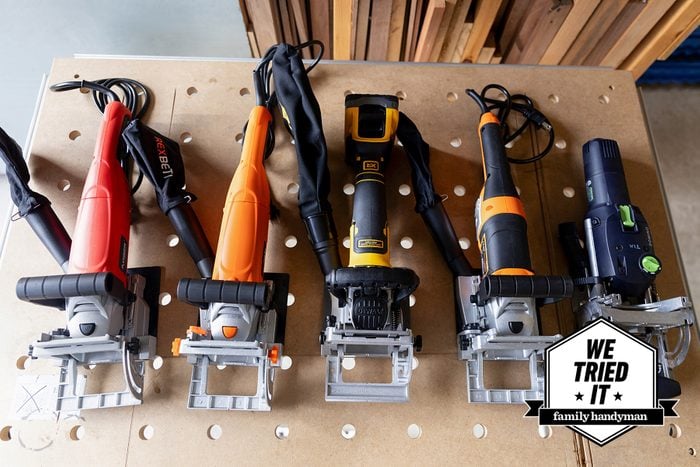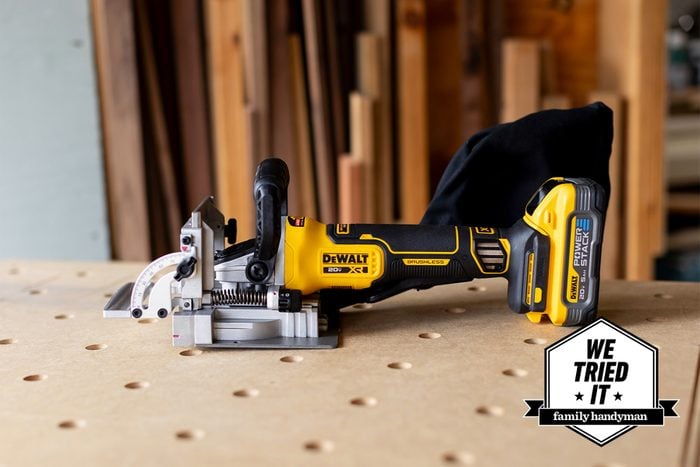
Best Overall Biscuit Joiner
DeWalt DCW682 20-Volt Biscuit Joiner
After putting a range of biscuit joiners through the paces, the Dewalt DCW682 was the clear winner. This joiner offers cordless convenience, especially ideal for those working at jobsites vs. in a shop. The tool runs on the DeWalt PowerStack 20-volt battery (sold separately), giving you all the amperes (amps) you need and delivering five hours of runtime, which translates to 300 joints or 600 cuts per charge. It’s an excellent option for anyone looking to take on DIY projects at home.
The fence on the Dewalt moves up and down on a rack-and-pinion mechanism, ensuring that the fence stays parallel to the blade for accurate joints every time. Some comparable models have fences that struggle to maintain a parallel plane without further fine-tuning, resulting in misaligned joints. While other biscuit joiners can feel top heavy, this joiner is nicely balanced with the battery acting as a counterweight. The cutting edge height is easy to adjust and the biscuit size dial is very easy to use. The dust collection allows the use of the bag or a vacuum hose.
With a slew of biscuit joiners on the market, Listi chose the DeWalt DW682 for her shop. “It has been an incredible tool that I have used for years on hundreds of projects. It is strong, powerful and does an excellent job on hardwoods and softwoods alike,” she says.
What’s included: The DeWalt comes with the biscuit joiner, pre-installed 4-inch blade, Torx key, wrench, dust bag, angled dust port and comprehensive instruction manual.
Pros
- Cordless convenience
- Rack-and-pinion adjustable fence
- Brushless motor
- Comprehensive manual that details main functions
Cons
- Doesn’t cut face frame biscuits
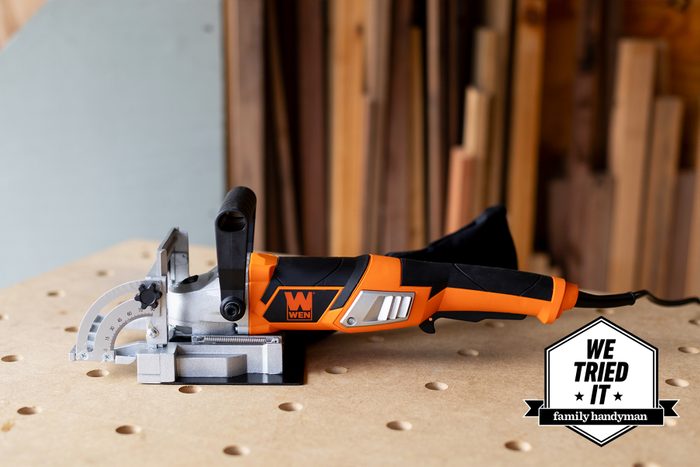
Best Value Biscuit Joiner
Wen JN8504 8.5-Amp Biscuit Joiner
The hallmark of a great value is excellent performance for a reasonable price, and that’s where the Wen biscuit joiner comes in. It’s one of the heavier biscuit joiners on the list, weighing almost 12 pounds. Regardless, it can handle a wide range of hardwoods, thanks to its powerful 8.5-amp motor, which is suitable for both beginners and professionals. It comes with everything you need to get started, including a hard case and common biscuit sizes (#0, #10 and #20). A removable dust bag attaches to a built-in dust port.
The Wen is easy to handle with its comfortable grip and smooth-plunge action. Both depth and locking knobs are on the right side of the fence, which is nice so you don’t have to use both hands to make adjustments. Your joiner is also covered by a two-year warranty. Overall, this is a great value for the weekend hobbyist or for occasional use.
What’s included: You’ll get the Wen biscuit joiner, detachable dust bag, spanner wrench, instructional manual, molded carrying case and biscuits in various sizes—#0 (10 pieces), #10 (16 pieces) and #20 (24 pieces).
Pros
- Sturdy case and biscuits included
- Built-in dust port with vacuum attachment
- Powerful 8.5-amp motor with 10,000 RPMs
- Preset stops for #0, #10 and #20 biscuits
Cons
- On the heavier side compared to other joiners
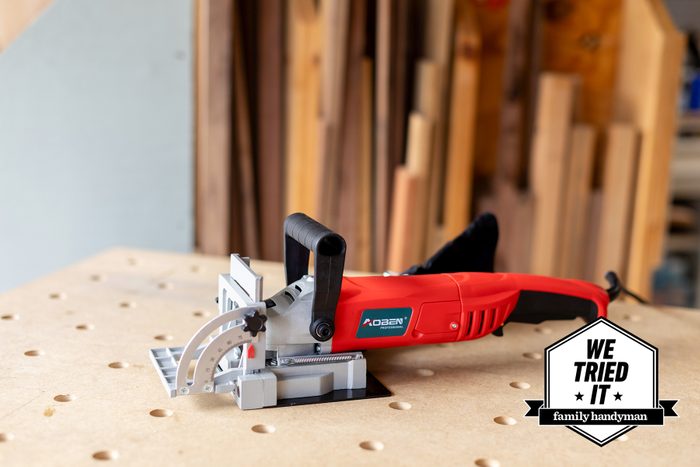
Best Biscuit Joiner for a Beginner
Aoben Biscuit Joiner
The Aoben option delivers precise and clean cuts every time with its 4-inch carbide-tipped blade that spins at 10,000 RPMs. The fence adjusts to 90 degrees, and features three preset depth levels to get exactly what you need. While the cutting depth is clearly displayed, the depth dial can be nudged out of place. This jointer has an anti-slip handle and includes a dust bag to keep work surfaces clean. Ideal for the beginner, this joiner comes with a wide selection of biscuits to get you started along with a hard, plastic carrying case.
While the Aoben doesn’t include a comprehensive manual, there are ample You Tube videos that cover step-by-step instructions to produce seven different joints, including edge-to-edge joints, frame joints, corner joints, offset joints, edge miter joint, and a T-joint where a fixed shelf meets the sides of a cabinet.
What’s included: The Aoben comes with the biscuit joiner, 4-inch tungsten carbide-tipped blade, spanner wrench, dust bag and biscuits in sizes #0 (30 pieces), #10 (30 pieces) and #20 (50 pieces).
Pros
- Includes a wide variety of biscuits
- Priced affordably and includes a carrying case
- Powerful 8.5-amp motor with 10,000 RPMs
- Comes with a two-year warranty
Cons
- Dust collection bag fills up quickly
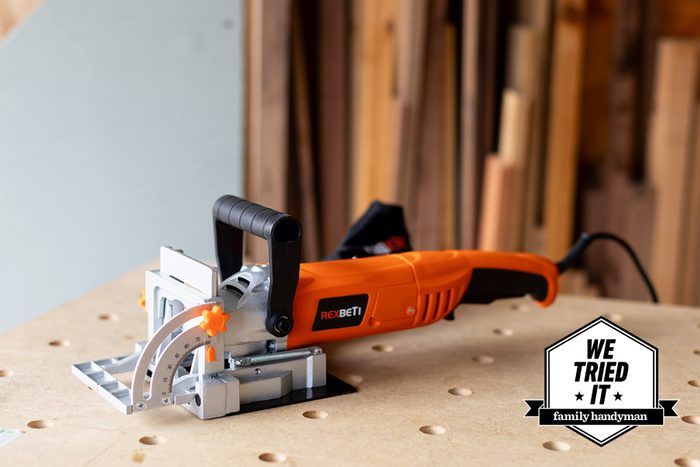
Best Biscuit Joiner for Out-of-the-Box Convenience
Rexbeti Wood Biscuit Plate Joiner Kit
At just seven pounds, the Rexbeti is the lightest joiner tested, making it ideal for extended use to avoid hand fatigue. It may be lightweight, but it delivers plenty of power with a motor generating 10,000 RPMs. This best biscuit joiner kit a top choices if you want out-of-the-box convenience.
The kit comes with 100 biscuits in in #0, #10 #20 sizes. The 4-inch carbide tipped blade comes pre-installed and makes accurate cuts for different joint types and angles. The fence is adjustable to 90 degrees with a bright orange-colored adjustment, locking dials to make angle and height adjustments a breeze. Unique to this model is a screw that needs to be removed before use or the blade will not retract.
What’s included: Your order includes the Rexbeti biscuit joiner, spanner wrench, detachable dust bag and biscuits in sizes #0 (10 pieces), #10 (20 pieces) and #20 (70 pieces).
Pros
- Features a safety-lock screw
- Weighs just 7 pounds
- Powerful motor with 10,000 RPMs
- Includes everything you need to get started
Cons
- Noisy operation when cutting
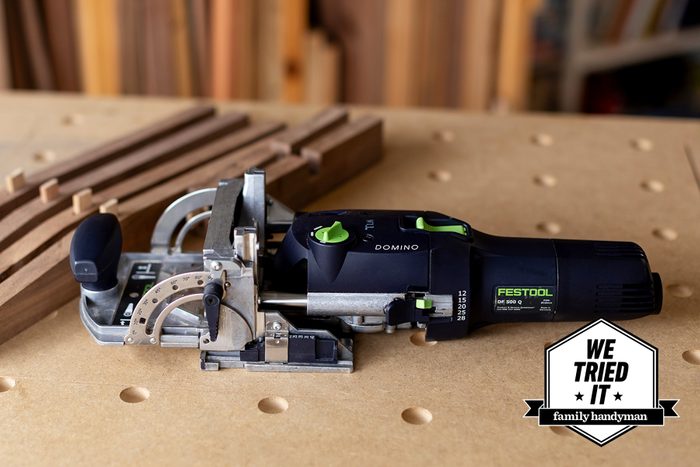
Best Biscuit Joiner for a Woodworker
Festool Domino Joiner
While not technically a biscuit joiner, the Festool domino joiner produces similar joinery, but instead of traditional biscuits, it uses rectangular-shaped tenons called dominos for rock-solid joinery. You have to have it hooked up to dust collection, as it creates so much dust and a dust clog can mean a broken bit. This means adding an adapter to your shop vacuum or investing in the Festool CT26E dust collector, which integrates with the domino and other Festool products.
When Festool released its domino tool in 2007, it was a game changer. It’s a floating tenon system with a high degree of accuracy and added strength. The tool has five mortising depths, an adjustable mortise width and a pivoting fence for angled mortises. Instead of a circular blade, this handheld, horizontal oscillating router has a spiral cutter to bore the mortises.
“The tenon, or domino, is made from solid birch, sipo, or metal allowing for use in interior, exterior and breakdown furniture applications,” explains Tom Noffsinger, a veteran woodworker for over 25 years. He chose the Festool for quick and precise work flow, moving from varied joints and wood species smoothly and with speed.
Logan Newman, owner of Newman Woodworking, uses this model for mortise and floating tenons, but also to create expansion slots in his custom furniture to allow wood movement. “The domino performs multiple jobs more efficiently and cost effectively than any other tool in the shop,” he explains. “If you’re a professional cabinetmaker or just a weekend warrior hoping to produce beautiful furniture, faster, the Festool is a standout option.”
What’s included: You’ll get the Festool domino joiner, cross stop, open-ended spanner (WAF 8), trim stop, 5-millimeter cutter and storage container.
Pros
- Stronger than doweling or biscuits
- More than twice as much gluing surface as biscuits
- Enhances speed in production
- Comes with a three-year warranty
Cons
- Expensive
What to Look for When Buying a Biscuit Joiner
Before making your final biscuit joiner selection, keep these considerations in mind:
- Cost: Biscuit joiners vary greatly in cost. “Entry-level biscuit joiners can start around $50 to the very high-end Lamello models that can top $700, so be sure to fit the tool to your needs,” suggests Listi.
- Power and speed: Ideally, look for a model with 6 to 8.5 amps, and 8,000 and 10,000 revolutions per minute (RPMs).
- Dust collection: Joiners have a small port that sends wood chips to a cloth bag. This works well for about a dozen biscuits, then the port tends to clog. You’ll want a dust collection system for bigger jobs and a joiner that can attach to a shop vacuum (you may need to add an adapter).
- Handle styles: You can choose between a barrel grip, where you’re actually grabbing the body of the machine, or a D-handle style, which is more comfortable, but less accurate.
- Fence features: Joiners have a fence that can be set up to 90 degrees, but you may want to use a joiner that can be set up to 135-degree angles. This allows you to set the joiner on the inside or outside face of a mitered joint. The fence should track up and down while allowing the fence to remain parallel to the blade. Look for a rack-and-pinion mechanism for adjusting the fence.
- Blade options: The 4-inch diameter blade is standard on most biscuit joiners, and is great for the common #0, #10 and #20 biscuits. But if you want to use your biscuit joiner for face frames, you’ll need a 2-inch blade and smaller biscuits. Not all biscuit joiners can fit the smaller blade, because the plunge mechanism has to be compatible with the smaller blade. If you find yourself using smaller biscuits for face frames, make sure your joiner can be retrofitted for this purpose.
- Additional features: Biscuit joiners may include some additional features, like hard carrying cases for easy storage when not in use. Many manufacturers included standard biscuit sizes so you have everything you need to get started.
Why You Should Trust Us
As an award-winning woodworker, I have experience with woodworking, DIY and home improvement. I’m also the owner of a one-woman woodworking studio where I make wooden educational toys and furniture using advanced joinery techniques. For this article, I also enlisted Sarah Listi, owner of Tool Girl’s Garage, a blog and social media presence dedicated to tool reviews, woodworking, renovation and construction. Listi is co-host of the Murder House Flip TV show on the Roku Channel.
Additionally, I consulted with two experienced woodworkers and furniture makers, Tom Noffsinger, a veteran woodworker for over 25 years who has attended Festool training as a serious hobbyist, and Logan Newman, owner of Newman Specials Woodwork and creator of jigs and tools for WeCNCthat store.
How We Found the Best Biscuit Joiners
In 1968, Lamello released the first biscuit joiner and, since then, this tool has been used in woodworking and home projects to offer quick, precise and strong joints. Selecting the best biscuit joiners to test depended on power output, accuracy, ease of use, reputable brands and customer reviews. Our top picks have powerful motors of 6 to 8.5 amps and from 10,000 to 12,000 RPMs. Feature must-haves include adjustable angles and cutting depths, 0- to 90-degree angles and dust collection. Taking all of that into consideration, I was able to dwindle the list down to the very best top five biscuit joiners.
FAQ
What does a biscuit joiner do?
A biscuit joiner is used to join two pieces of wood together using concealed joints. The joiner leaves an arched slots into the mating edges of the wooden pieces that takes compressed wood biscuits. When glue makes contact with the compressed wood, the biscuit expands to make a tight joint, perfect for manufactured material like medium-density fiberboard (MDF) and plywood.
The biscuit joiner can do many different joints, like edge-to-edge joints, splines on mitered boxes and biscuit cutting slots for table clips. Miter joints are another ideal place for biscuits. Using a biscuit joiner on mitered parts is a smart way to add strength to the joint and prevent the two halves from slipping as you apply clamp pressure. I particularly like biscuits for attaching face frames to plywood cabinets without pesky holes that require patching. I don’t like to use hardware in my projects, only wood joints. So when I want to do a panel glue-up, I use the biscuit joiner for alignment. The biscuit joint is used for its accuracy and speed while being quick to learn.
Is a biscuit joint the same as domino joint?
Biscuit joints and domino joints are similar in that they are seamless, concealed joints used to connect two pieces of wood together. However, they differ in the method and type of joinery they provide.
Biscuit joinery involves using curved wooden biscuits made from compressed wood, typically beech. They provide alignment assistance and some added strength to the joint, but they’re not as strong as other joinery methods, like mortise and tenon.
Domino joinery uses a floating tenon system. A handheld, oscillating router with spiral cutter creates the corresponding holes. Instead of inserting biscuits, it uses pre-made, elongated loose tenons called dominos, which are fitted into the mortise. The machine cuts mortises and the dominos act as floating tenons. Domino joints offer superior strength compared to biscuit joints, due to the larger and more substantial surface area for glue adhesion and the mechanical interlock between the tenon and mortise.
While both techniques assist in aligning pieces and strengthening joints, Domino joinery generally offers more strength compared to biscuit joints.
Sources:
- Sarah Listi, owner of Tool Girl’s Garage
- Tom Noffsinger, a veteran woodworker
- Logan Newman, owner of Newman Specials Woodwork and creator of jigs and tools for WeCNCthat store

